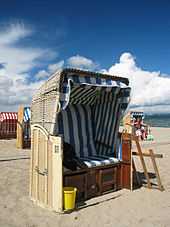Strandkorb



A strandkorb (German: literally beach basket; Danish: strandkurv; English sometimes beach chair) is a special chair designed to provide comfort and protection from sun, wind, rain, and sand on beaches frequented by tourists.
Strandkorbs are predominantly used on the coasts of North Sea and Baltic Sea, as well as other coasts with considerable winds. During the summer months, they can usually be rented from strandkorb keepers. Two different shapes can be distinguished, the straight angular North Sea variety and the round rolling Baltic Sea variety.
The strandkorb was invented in 1882 by German basketmaker Wilhelm Bartelmann in Rostock, on request of a tourist from Warnemünde. In 1883, he announced the first rental service in a local newspaper. The first models were single seaters and appeared quickly on other parts of the German coast. Today's models are mostly two seaters with tiltable tops, some allowing people to lie down completely. They are equipped with armrests and footrests, storage space below the seats, rain proof covers and sunshades.
Thomas Mann refers to strandkorbs (using the words Strandkorb and Sitzkorb) in his 1901 novel Buddenbrooks, setting the context in the 1840s on the beach at Travemünde.
Special designs

When the 2007 G8 summit in Heiligendamm met in June 2007, the Marketing Department of the State of Mecklenburg-Vorpommern provided a special beach chair manufactured specifically for the leaders of the eight participating states and the President of the European Commission to use for a final photo. These photographs taken on June 8, 2007 have gained some international notoriety. The beach chair is a good two meters high and almost six meters long. It was produced by the traditional Korb GmbH of Heringsdorf on the Baltic island of Usedom. All employees of the company were involved in the production of the chair, which lasted three weeks. It needed two kilometres of interlace, a cubic meter of timber, sourced from domestic pine, and 35 square meters blue and white cloth.[1] The sun awning was printed with the respective country flags.
After the event the beach chair was transported to different locations over some months as an item of interest for tourists and locals. Among other things, it was displayed in Berlin in front of the Chancellor's Office, at the Brandenburg Gate, and the day of German unity on October 3, 2007 in Schwerin. In November 2007 the beach chair was auctioned off in in aid of the charity Ein Herz für Kinder. The founder of the Deutsche Vermögensberatung AG (DVAG), Reinfried Pohl, purchased it for the price of one million Euros. Since 2008 it is used for further fund-raising.[2]
References
- ↑ "Wie ging es weiter für ...... den Hersteller des G8-Strandkorbs?". Die Zeit. December 7, 2007. Retrieved June 9, 2014.
- ↑ "Ein Korb für die Mächtigen der Welt". NDR. May 23, 2007. Retrieved November 28, 2012.
External links
| Wikimedia Commons has media related to Strandkorb. |